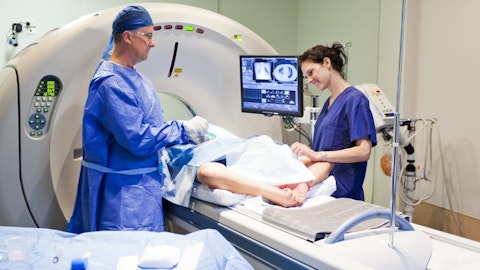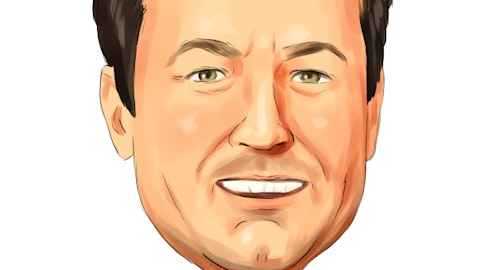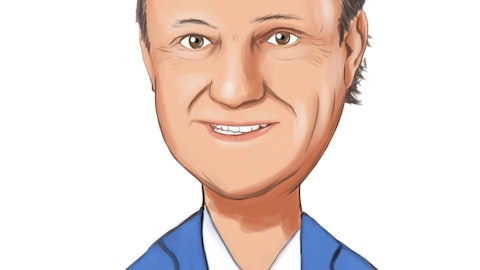Branislav Vajdic: Yes. When it comes to deep learning in – in general AI, it’s always — it’s in the headlines in terms of its impact on various areas of our society. And in the future impact is really quite – quite relevant when it comes to medical area. So all in all, looking at the impact AI will have on specific area of ECG, we believe that it’s going to be impactful. And that technology combined with our unique advantages that we call the data – data set and very importantly, longitudinal data set collected over time, frequently over time for that patient will provide, we believe, value that goes beyond what a data set, traditional data set of 12 Lead VECGs can offer. So we are keenly interested in AI, and we will be making some announcement in terms of our plans and efforts in this area in the near future.
Unidentified Company Representative: Our next question asked, do you have enough capital for 2025 commercial launch?
Rick Brounstein: So, that sounds like a good question for the CFO.
Unidentified Company Representative: Yes.
Rick Brounstein: Yes. So, a couple of points on that. Yes, we have enough money to get through the second FDA clearance, which is the commercial product and get it ready for launch. That said, we clearly plan to do another round of financing to fully fund the commercialization, so a little bit of both, but we have probably several months of leeway between when we expect to get ready for commercialization and when we would need another round to really carry on. So we’re feeling very comfortable from the cash position today.
Unidentified Company Representative: The next question asks, what are your near-term milestones?
Rick Brounstein: We made a decision to approach our regulatory submissions in two steps. The first one is what we call V1 system, the hardware system, the credit card besides hardware system, it’s very important foundational to our ability to synthesize that were synthesized we lead is our second submission to be too clear and we’ll be seeking for the 12 weeks. And indeed, as it stands right now, we expect both of these to be cleared in 2024.
Unidentified Company Representative: Our next question asks, can you talk about new business development opportunities?
Rick Brounstein: Rob?
Rob Eno: Sure. I can take that one. Branislav touched on that in his overview of the new technologies. So our focus, obviously, right now is on the AIMIGo system, getting that through FDA and commercializing that. And as we described, we believe we’re making really good progress on that. That is very much our company’s focus. At the same time, we have this rich pipeline of products would that have strong IP associated with them. So the continuous monitor watch, what we call the integrated system, which is the watch plus the card and also the 12-lead ECG HeartBeam watch. And we think some of those, given the size of our company, really lend themselves well the strategic partnerships, especially in the area of wearables and ambulatory monitoring.
So we will — we’re going to be pursuing discussions in the coming months with companies for some of those future areas. And maybe I’ll just — I touched on another question that I had seen come through, which is on the go-to-market strategy for the for the AIMIGo system. And so we are planning to go forward bringing that product to market ourselves. We’re going to be unveiling more about what our go-to-market plans are. We are making good progress in developing those plans. And in the coming months, we’ll outline them in a lot more detail.
Unidentified Company Representative: Our next question asks, per CMS guidelines for chest pain patients, is to go to the emergency department. And therefore, how do — do you plan on becoming a CMS guideline?
Rob Eno: Yes. I’ll — I can take that one as well. It’s another really interesting question. First of all, the right the guidelines are if you have chest pain, you should go to the emergency room, the reality is patients often delay three to four hours before going. We think that’s really one of the fundamental issues that exist today. The ultimate goal is for this technology to be accepted and go down a path of unique reimbursement as well as getting into the guidelines. And so the short answer is that will all be done with studies and evidence. It’s going to be really important for us to generate evidence and data that show the clinical effectiveness and the cost effectiveness. And so it takes time, ultimately, but with evidence showing the benefit when patients use this device, that’s the kind of work that would ultimately help to get something like this into the guidelines.
A – Unidentified Company Representative: And our last question asks, where do you see the 3-Lead finding a market. There are several dozen companies in this market? And what is the value of another 3-Lead?
Rob Eno: Yes, I can take that one as well. Now these are touching on some really good points. When we talk about our 3-Lead collection device, it is collecting 3 orthogonal leads, X, Y and Z. And that’s the basis of vector cardiography VCG. And when you’re collecting those specific 3 axis, that gives you all the data — all the electrical data in the heart from that you can then synthesize the 12-Lead. Other 3-Lead devices, other reduced lead set devices are not using 3-orthogonal leads. So they’re not — their projections that aren’t getting the full signal. So our difference for the 3-Lead is that we are 3-Lead VCG, so we’re collecting all the heart signals. But as we’ve laid out the strategy, it’s a stepwise approach, getting the hardware cleared as a 3-Lead collection device that allows us to move on to taking those 3 orthogonal leads and then synthesizing the 12-Lead.
We believe it’s important for physicians who are involved, as we mentioned earlier, to be able to analyze the 12-Lead together with the baseline because that’s what they’re used to seeing. So it’s a stepping stone having the 3 orthogonal leads to get to the 12-Lead synthesis, which is our true differentiator.




